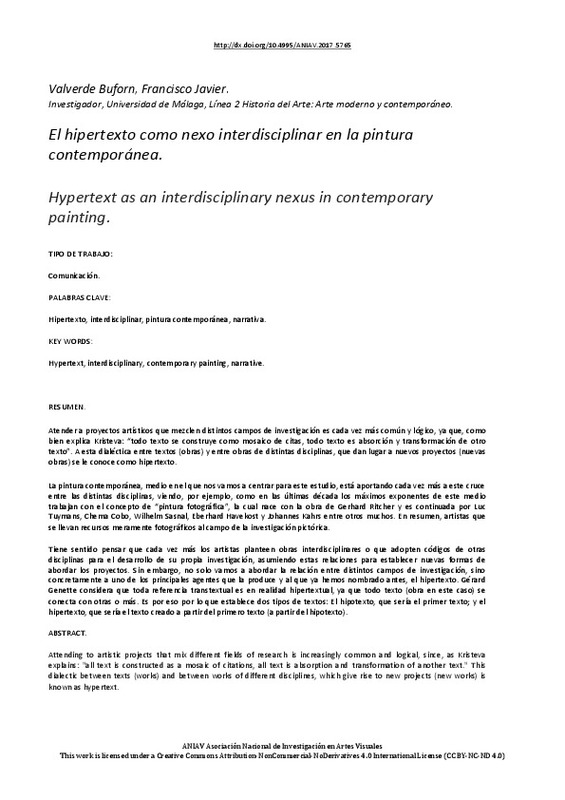|
Resumen:
|
[EN] Attending to artistic projects that mix different fields of research is increasingly common and logical, since, as Kristeva explains: "all text is constructed as a mosaic of citations, all text is absorption and ...[+]
[EN] Attending to artistic projects that mix different fields of research is increasingly common and logical, since, as Kristeva explains: "all text is constructed as a mosaic of citations, all text is absorption and transformation of another text." This dialectic between texts (works) and between works of different disciplines, which give rise to new projects (new works) is known as hypertext.
Contemporary painting, the medium in which we are going to focus for this study, is increasingly contributing to this cross between the different disciplines, seeing, for example, how in the last decade the greatest exponents of this medium work with the concept of "Photographic painting", which was born with the work of Gerhard Ritcher and is continued by Luc Tuymans, Chema Cobo, Wilhelm Sasnal, Eberhard Havekost and Johannes Kahrs among many others. In short, artists who take merely photographic resources into the field of pictorial research.
It makes sense to think that more and more artists submit interdisciplinary works or adopt codes of other disciplines for the development of their own research, assuming this relationships to establish new ways of approaching projects. However, we will not only address the relationship between different fields of research, but specifically one of the main agents that produces it and which we have already named, hypertext. Gérard Genette considers that all transtextual reference is actually hypertextual, since all text (work in this case) is connected with others or more. That is why it establishes two types of texts: The hypotext, which would be the first text; And hypertext, which would be the text created from the first text (from the hypotext).
[-]
[ES] Hoy en día parece que las relaciones interdisciplinares están cada vez más asumidas por los artistas y por lo tanto permite una mayor y profunda investigación sobre la obra que realizan. Una de las grandes llaves para ...[+]
[ES] Hoy en día parece que las relaciones interdisciplinares están cada vez más asumidas por los artistas y por lo tanto permite una mayor y profunda investigación sobre la obra que realizan. Una de las grandes llaves para está comunicación entre las distintas disciplinas es lo que se conoce como “hipertexto”. Como ya es sabido, la hipertextualidad se refiere a la relación entre dos textos literarios distintos – o más bien entre la obra que vemos (hipertexto), y la obra a la que se refiere (hipotexto) – . Sin embargo, esta relación no tiene porque ser con obras pertenecientes a un mismo campo, sino que se pueden establecer relaciones entre literatura, pintura, escultura, cine, vídeo, etc. Generando así conexiones más rizomáticas, capaces de crear caminos entre los distintos medios. La pintura juega un papel fundamental en este cruce disciplinar, ya que ha sabido adquirir códigos de otros medios, como puede ser el cine, o generar recursos propios para conectar con otras obras y potenciar así su carácter narrativo. Es muy frecuente ver como los pintores contemporáneos entiendes los cuadros como fotográmas, secuencias, fragmentos, etc. O como usan recursos como las citas para establecer un diálogo con otra obra a la que se refiere y actualizar o proponer nuevos conceptos. Ejemplo de ello son artistas como Wilhelm Sasnal, Simon Zabell, Victor Man, Ugo Rondinone o Ilya y Emilya Kabakov, cuyas obras se enriquecen del hipertexto.
[-]
|








